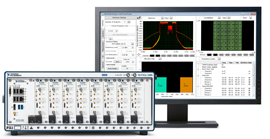The new WLAN Test Toolkit 17.0 supports comprehensive 802.11ax multiuser test with excellent error vector magnitude performance
Bangalore, India – May 8, 2017 – NI (Nasdaq: NATI), the provider of platform-based systems that enable engineers and scientists to solve the world’s greatest engineering challenges, announced today the WLAN Test Toolkit 17.0 with support for Draft 1.1 of the IEEE 802.11ax standard. Combined with NI’s second-generation Vector Signal Transceiver (VST), the WLAN Test Toolkit 17.0 supports 802.11ax waveform generation and analysis for characterization, validation and production test of products, such as RF front end components, wireless modules and user devices, that implement Draft 1.1 of the IEEE 802.11ax standard.
 The WLAN Test Toolkit 17.0 empowers designers and engineers with the ability to generate and analyze a wide range of 802.11ax standard-compliant waveforms, including extended single user, multiuser OFDMA and multiuser multiple input, multiple output (MIMO) with per-user configuration and measurement results. The toolkit helps users solve demanding new access point test cases by generating signals that simulate multiuser environments, including per-user impairments. Engineers can also use the new software to generate trigger frames to test the real-time response of client devices and make power pre-correction and relative center frequency measurements.
The WLAN Test Toolkit 17.0 empowers designers and engineers with the ability to generate and analyze a wide range of 802.11ax standard-compliant waveforms, including extended single user, multiuser OFDMA and multiuser multiple input, multiple output (MIMO) with per-user configuration and measurement results. The toolkit helps users solve demanding new access point test cases by generating signals that simulate multiuser environments, including per-user impairments. Engineers can also use the new software to generate trigger frames to test the real-time response of client devices and make power pre-correction and relative center frequency measurements.
“As the standardization and evolution of 802.11ax continues, engineers require a software-centric test approach that can keep pace with the latest standard features and challenging new test cases,” said Charles Schroeder, vice president of RF marketing at NI. “Taking advantage of NI’s modular platform and second-generation VST can help users lower their cost of test and reduce time to market.”
With the WLAN Test Toolkit 17.0 and second-generation VST, engineers can configure up to 8×8 MIMO systems in a single PXI chassis. Users can also expect EVM measurements better than -50 dB, leading to rigorous device characterization and reliable test results. Furthermore, engineers can control their systems with the toolkit’s generation and analysis soft-front panels, and benefit from extensive LabVIEW, C and .NET system design software APIs and example code when programming and automating their systems.
The WLAN Test Toolkit 17.0 expands NI’s wide-ranging product portfolio for testing 802.11a/b/g/j/n/p/ac/ax, Bluetooth, 2G, 3G, 4G, FM/RDS, GNSS and low-power Internet of Things (IoT) wireless standards. NI’s platform-based approach helps ensure that users can update their existing PXI RF test systems to support 802.11ax device testing with a simple software update, and continue to do so as the 802.11ax standardization process evolves. Engineers can take advantage of this smarter approach to RF test to help lower their cost of test and better prepare for future connectivity and cellular standardization initiatives, such as 5G.
To learn more about NI’s solutions for 802.11ax, visit www.ni.com/80211ax/.






